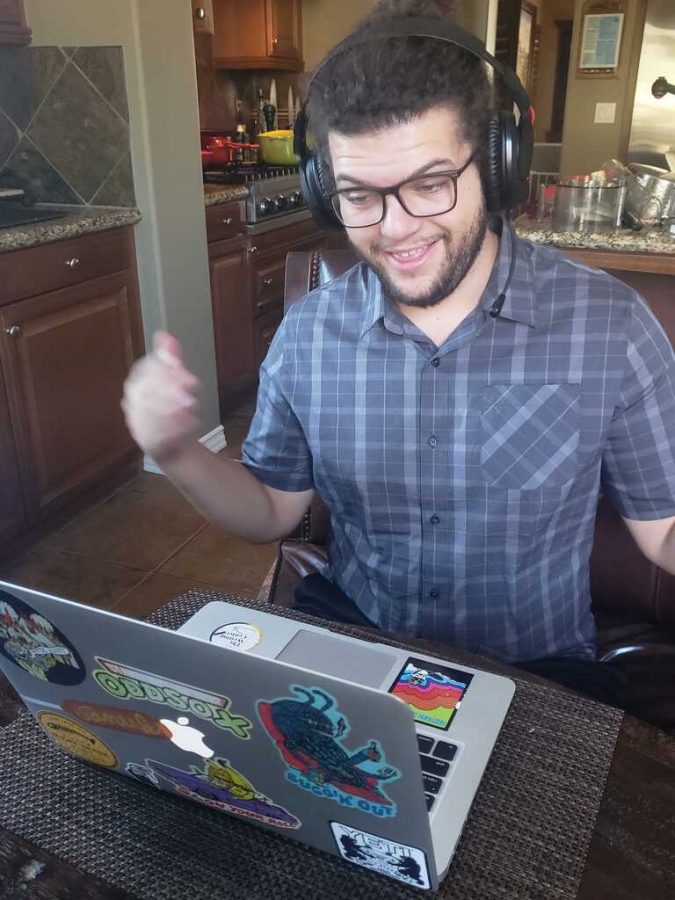IES students complete fieldwork on Zoom
Jay Knee, a student in the Graduate School of Education, leads a class at Channel Islands High School from his home.
September 25, 2020
The California Lutheran University Interdisciplinary Education Studies program requires students to complete 200 hours of fieldwork–student teaching–before graduation. During the pandemic, much of that classroom time is being completed via Zoom.
“Many of our students spend 200 to 300 hours in the classroom, which makes them highly desirable later on,” said Michael McCambridge, Professor and Director of IES. “We’ve had to really talk about how we can do that [remotely].”
As COVID-19 social-distancing guidelines have continued to prevent students from returning to classrooms, IES students have found alternative means of completing their fieldwork.
“My students are required to complete 60 hours of fieldwork in a normal year,” said Kristen Walker, adjunct Professor of IES and Principal of Meadows Arts and Technology Elementary School. “This year obviously, the vast majority of schools in the county are closed…so many are doing virtual schooling.”
Walker said that IES students have been able to join in on class Zoom meetings, collaborate with teachers online, and have interactions with students in small breakout groups on Zoom, Walker said.
“I have some students who are actually working physically with [primary school] students in their homes,” Walker said.
Cal Lutheran and MATES, a charter school in Thousand Oaks, are in a formal partnership called the Community Collaboration School Partnership. This means IES majors can be placed in MATES classrooms to complete their fieldwork.
Many IES students, including senior Gabrielle Espinosa, experienced interruptions to their ability to teach lessons in the spring.
“For me, I was taking my capstone actually in the spring,” Espinosa said. “Because of COVID I did not get to actually teach any of my actual lessons for my unit … I ended up having to throw [out] all the plans and just submit them we never actually got to teach them.”
Now, Espinosa is able to count the hours that she helps the children she nannies learn remotely toward fieldwork hours because the department “loosened” the requirements for how students complete their fieldwork, she said.
“They Zoom into class in the morning, and for the rest of the day they have work through Google Classroom, and I’m more there to help the students through the rest of the day since they don’t have a teacher who’s actually like there facilitating the online work,” Espinosa said. “It has been nerve-racking to think that my basically my last year and a half of college I won’t have any in-class experience at all.”
Despite the change in platform, Cal Lutheran IES students are still finding adaptations to learning prepare themselves for their future.
“Our majors are very enthusiastic in pursuing this career,” McCambridge said. “I do surveys of who gets jobs and we’re right up there with 90%.”
In addition to virtual options, if IES majors have personal ties to schools or feel comfortable doing in-person fieldwork this fall, they are permitted to do so.
“I think it’s a personal decision to put yourself into that situation,” McCambridge said. “I would be opposed to our students doing that if the schools weren’t taking great caution…we’ve checked that out when students are telling us that and so far we are satisfied. That’s the best kind of field experience when you can do that on a regular basis.”
This article was updated Oct. 1 at 9:30 a.m. to represent that Gabrielle Espinosa experienced interruptions to her IES coursework in the spring and is now earning fieldwork hours through facilitating remote learning for children that she takes care of. A previous version said that Espinosa was watching the Teaching Channel as a substitute for fieldwork in the spring and is currently teaching courses via Zoom.



